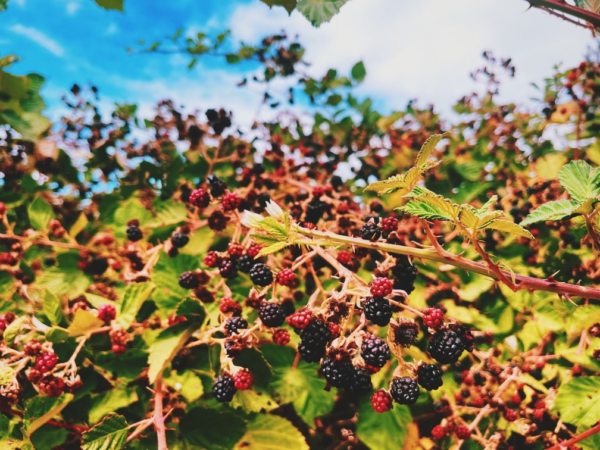The following is an excerpt from a book about a mother and daughter’s journey through cooking and learning the earth.
Blackberries take me right back to my childhood. They stir up memories of summer adventure in oppressive August heat, and my wonderful friend Nicoll. I can still picture exactly where the best blackberries grew near my house. Nicoll and I grew up in the country, northeast of Philadelphia, surrounded by beautiful rolling hills and old forests, old stone walls. Nicoll and I were ten at the time of what became, for several years, our annual blackberry forage. We would put on the thickest jeans we had, long sleeve flannel shirts, socks, sneakers, and bandanas. The thorns on wild blackberries are fierce. Even with all that protection we came home with scratches all over our hands and arms. We were hot, sweaty, and itchy. But, somehow, it made the whole experience feel that much more precious and the berries all the sweeter. Our fingers and lips were purple from cramming so much fruit into our mouths. We did manage to bring some home in our basket to share with the rest of the family.
Small Batch Blackberry Jam
1 pound blackberries (Some of the blackberries should have a little red. These red ones will be high in pectin and help your jam to set.)
1 ½ cups organic raw sugar
1 tablespoon lemon juice
Before you get started place a small dish in the freezer.
Pour the blackberries into a thick bottomed saucepan and mash with a potato masher. Add the sugar and lemon juice. Heat over medium heat, stirring until the sugar melts and is completely dissolved. Raise the heat to medium high and boil until a drop mounds on your chilled dish.
Pour the jam into a pint jar with a tight fitting lit. Store in the refrigerator. The jam can last in the fridge for several weeks, but I think it will be gone long before that!

 Get access to the monthly Rehumanization Magazine featuring contributors from the front lines of this effort—those living on Death Row, residents of the largest women’s prison in the world, renowned ecologists, the food insecure, and veteran correctional officers alike.
Get access to the monthly Rehumanization Magazine featuring contributors from the front lines of this effort—those living on Death Row, residents of the largest women’s prison in the world, renowned ecologists, the food insecure, and veteran correctional officers alike.